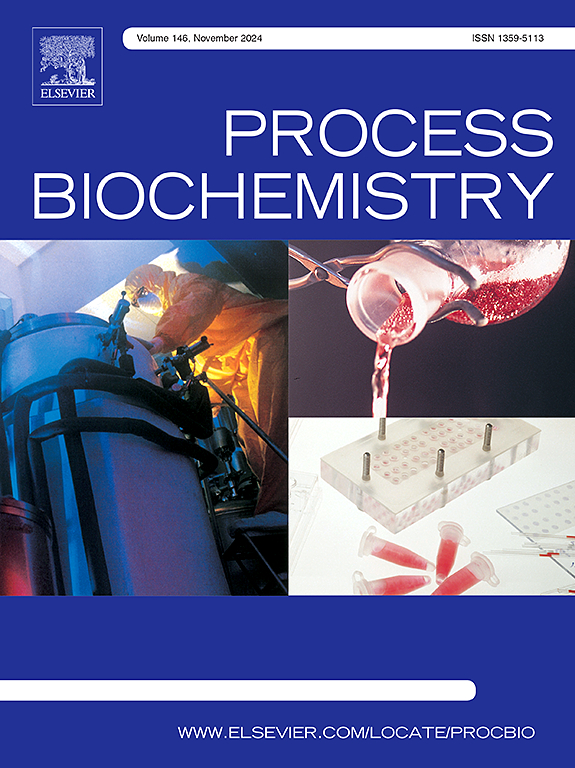Regulation of the interaction between the de novo biosynthesis of vitamin B6 and its salvage pathway for efficient production of pyridoxine
IF 4
3区 生物学
Q2 BIOCHEMISTRY & MOLECULAR BIOLOGY
引用次数: 0
Abstract
Vitamin B6, a micronutrient essential for maintaining healthy growth and normal physiological function, is a generic term for six interconvertible substances, of which pyridoxine hydrochloride is the most common commercial form, produced industrially by chemical processes using expensive and/or toxic chemicals. To date, attempts to engineer microorganisms to produce high-level of vitamin B6 have been unsuccessful due to the toxic intermediates and a lack of understanding of the vitamin B6 metabolism regulation. Here, for the first time, we proposed a two-step process for efficient pyridoxine production. A recombinant Escherichia coli was successfully engineered to produce 1406 mg/L of pyridoxal phosphate by interfering with only one or two key enzyme genes expression in the vitamin B6 salvage pathway. Pyridoxal phosphate was then efficiently converted to pyridoxine by another engineered Escherichia coli overexpressing cell membrane-anchored phosphatase YbhA and pyridoxal reductase PdxI, and 2296 mg/L (calculated as pyridoxine hydrochloride) of pyridoxine was achieved with a yield of 0.29 mol/mol (pyridoxine hydrochloride/pyridoxal phosphate) by shake flask cultivation. This achievement marked a significant advance in the biological synthesis of vitamin B6 and demonstrated an efficient vitamin B6 production strategy by reducing interference between the de novo synthesis pathway and the salvage pathway of vitamin B6.
维生素B6的新生生物合成及其有效生产吡哆醇的补救途径之间相互作用的调控
维生素B6是维持健康生长和正常生理功能所必需的微量营养素,是六种可相互转化物质的总称,其中盐酸吡哆醇是最常见的商业形式,工业上通过使用昂贵和/或有毒化学品的化学过程生产。迄今为止,由于有毒的中间体和缺乏对维生素B6代谢调节的理解,试图通过工程微生物来产生高水平的维生素B6的尝试一直不成功。在这里,我们首次提出了一种高效生产吡哆醇的两步法。通过干扰维生素B6回收途径中一个或两个关键酶基因的表达,成功地构建了一株重组大肠杆菌,产生了1406 mg/L的磷酸吡哆醛。通过另一种过表达膜锚定磷酸酶YbhA和吡哆醇还原酶PdxI的工程大肠杆菌,有效地将磷酸吡哆醇转化为吡哆醇,摇瓶培养得到2296 mg/L(以盐酸吡哆醇计算)的吡哆醇,产量为0.29 mol/mol(盐酸吡哆醇/磷酸吡哆醇)。这一成果标志着维生素B6的生物合成取得了重大进展,并通过减少维生素B6从头合成途径和回收途径之间的干扰,证明了一种有效的维生素B6生产策略。
本文章由计算机程序翻译,如有差异,请以英文原文为准。
求助全文
约1分钟内获得全文
求助全文
来源期刊

Process Biochemistry
生物-工程:化工
CiteScore
8.30
自引率
4.50%
发文量
374
审稿时长
53 days
期刊介绍:
Process Biochemistry is an application-orientated research journal devoted to reporting advances with originality and novelty, in the science and technology of the processes involving bioactive molecules and living organisms. These processes concern the production of useful metabolites or materials, or the removal of toxic compounds using tools and methods of current biology and engineering. Its main areas of interest include novel bioprocesses and enabling technologies (such as nanobiotechnology, tissue engineering, directed evolution, metabolic engineering, systems biology, and synthetic biology) applicable in food (nutraceutical), healthcare (medical, pharmaceutical, cosmetic), energy (biofuels), environmental, and biorefinery industries and their underlying biological and engineering principles.
 求助内容:
求助内容: 应助结果提醒方式:
应助结果提醒方式:


